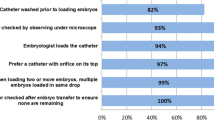Abstract
Objectives
To study the effect of embryo transfer (ET) catheter contact with intravaginal progesterone preparations on mouse embryo development.
Study Design
In a simulated ET model, ET catheters were loaded with culture medium, placed in contact with intravaginal progesterone gel (Crinone 8%) or micronized progesterone intravaginal inserts (Endometrin 100 mg), and the intracatheter culture medium flushed. Embryos were cultured in the flushed culture medium at variable dilutions for variable lengths of time. Proportion of embryos progressing to blastocyst, embryo cell number, and apoptotic index was analyzed.
Results
None of the embryos cultured in undiluted progesterone-exposed medium progressed to blastocyst. The likelihood of achieving blastocyst status and the average embryo cell number increased significantly as culture media exposed to intravaginal progesterone was diluted. A significant decrease in cell number became apparent between 1 and 2 hours of exposure. Interestingly, the apoptotic index was significantly higher in progesterone-exposed embryos as compared to unexposed embryos.
Conclusion
The contamination of ET catheter with intravaginal progesterone significantly impairs mouse embryo development, likely due in part to increased programmed cell death.
Similar content being viewed by others
References
Devoto L, Fuentes A, Kohen P, Cespedes P, et al. The human corpus luteum: life cycle and function in natural cycles. Fertil Steril. 2009;92(3):1067–1079.
Csapo AI, Pulkkinen MO, Wiest WG. Effects of luteectomy and progesterone replacement therapy in early pregnant patients. Am J Obstet Gynecol. 1973;115(6):759–765.
Navot D, Bergh PA, Williams M, et al. An insight into early reproductive processes through the in vivo model of ovum donation. J Clin Endocrinol Metab. 1991;72(2):408–414.
Rosenwaks Z. Donor eggs: their application in modern reproductive technologies. Fertil Steril. 1987;47(6):895–909.
Lelaidier C, de Ziegler D, Freitas S, Olivennes F, Hazout A, Frydman R. Endometrium preparation with exogenous estradiol and progesterone for the transfer of cryopreserved blastocysts. Fertil Steril. 1995;63(4):919–921.
Acosta AA, Elberger L, Borghi M, et al. Endometrial dating and determination of the window of implantation in healthy fertile women. Fertil Steril. 2000;73(4):788–798.
Wanggren K, Stavreus-Evers A, Olsson C, Andersson E, Gemzell-Danielsson K. Regulation of muscular contractions in the human Fallopian tube through prostaglandins and progestagens. Hum Reprod. 2008;23(10):2359–2368.
Bulletti C, de Ziegler D. Uterine contractility and embryo implantation. Curr Opin Obstet Gynecol. 2006;18(4):473–484.
Nosarka S, Kruger T, Siebert I, Grove D. Luteal phase support in in vitro fertilization: meta-analysis of randomized trials. Gynecol Obstet Invest. 2005;60(2):67–74.
Nyboe Andersen A, Popovic-Todorovic B, Schmidt KT, et al. Progesterone supplementation during early gestations after IVF or ICSI has no effect on the delivery rates: a randomized controlled trial. Hum Reprod. 2002;17(2):357–361.
Daya S, Gunby J. Luteal phase support in assisted reproduction cycles. Cochrane Database Syst Rev. 2004;(3):CD004830.
Zarutskie PW, Phillips JA. A meta-analysis of the route of administration of luteal phase support in assisted reproductive technology: vaginal versus intramuscular progesterone. Fertil Steril. 2009;92(1):163–169.
Yanushpolsky E, Hurwitz S, Greenberg L, Racowsky C, Hornstein M. Crinone vaginal gel is equally effective and better tolerated than intramuscular progesterone for luteal phase support in in vitro fertilization–embryo transfer cycles: a prospective randomized study. Fertil Steril. 2010;94(7):2596–2599.
Propst AM, Hill JA, Ginsburg ES, Hurwitz S, Politch J, Yanushpolsky EH. A randomized study comparing Crinone 8% and intramuscular progesterone supplementation in in vitro fertilization–embryo transfer cycles. Fertil Steril. 2001;76(6):1144–1149.
Silverberg K, Vaughn TC, Hansard L, Burger NZ, Minter T. Progesterone vaginal gel vs. intramuscular progesterone in oil for luteal support in IVF: a large, prospective trial. Fertil Steril. 2012;97(2):344–348.
Tavaniotou A, Smitz J, Bourgain C, Devroey P. Comparison between different routes of progesterone administration as luteal phase support in infertility treatments. Hum Reprod Update. 2000;6(2):139–148.
Blake EJ, Norris PM, Dorfman SF, Longstreth J, Yankov VI. Single and multidose pharmacokinetic study of a vaginal micronized progesterone insert (Endometrin) compared with vaginal gel in healthy reproductive-aged female subjects. Fertil Steril. 2010; 94(4):1296–1301.
Fanchin R, De Ziegler D, Bergeron C, Righini C, Torrisi C, Frydman R. Transvaginal administration of progesterone. Obstet Gynecol. 1997;90(3):396–401.
Liang X, Zhang XH, Han BC, et al. Progesterone and heparin-binding epidermal growth factor-like growth factor regulate the expression of tight junction protein Claudin-3 during early pregnancy. Fertil Steril. 2013;100(5):1410–1418. doi:10.1016/j.fertn-stert.2013.07.001.
Liu N, Zhou C, Chen Y, Zhao J. The involvement of osteopontin and β3 integrin in implantation and endometrial receptivity in an early mouse pregnancy model. Eur J Obstet Gynecol Reprod Biol. 2013;170(1):171–176.
Herrler A, von Rango U, Beier HM. Embryo–maternal signalling: how the embryo starts talking to its mother to accomplish implantation. Reprod Biomed Online. 2003;6(2):244–256.
Zeman M, Novakova P. Gestational progesterone suppresses embryotoxic action of the complement system to chick embryo. Neuro Endocrinol Lett. 2001;22(1):33–37.
Choi BC, Polgar K, Xiao L, Hill JA. Progesterone inhibits in-vitro embryotoxic Th1 cytokine production to trophoblast in women with recurrent pregnancy loss. Hum Reprod. 2000;15 suppl 1:46–59.
Harini C, Sainath SB, Reddy PS. Progesterone administration induces preimplantation embryonic loss in mice. Fertil Steril. 2009;91(5 suppl):2137–2141.
Mains L, Van Voorhis BJ. Optimizing the technique of embryo transfer. Fertil Steril. 2010;94(3):785–790.
Moore DE, Soules MR, Klein NA, Fujimoto VY, Agnew KJ, Eschenbach DA. Bacteria in the transfer catheter tip influence the live-birth rate after in vitro fertilization. Fertil Steril. 2000;74(6): 1118–1124.
Egbase PE, Al-Sharhan M, al-Othman S, al-Mutawa M, Udo EE, Grudzinskas JG. Incidence of microbial growth from the tip of the embryo transfer catheter after embryo transfer in relation to clinical pregnancy rate following in-vitro fertilization and embryo transfer. Hum Reprod. 1996;11(8):1687–1689.
Author information
Authors and Affiliations
Corresponding author
Rights and permissions
About this article
Cite this article
Ying, L.Y., Ying, Y., Mayer, J. et al. Embryo Transfer Catheter Contamination With Intravaginal Progesterone Preparations in a Simulated Embryo Transfer Model Impairs Mouse Embryo Development: Are There Implications for Human Embryo Transfer Technique?. Reprod. Sci. 21, 1000–1005 (2014). https://doi.org/10.1177/1933719114522522
Published:
Issue Date:
DOI: https://doi.org/10.1177/1933719114522522




